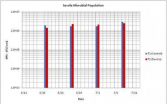(Press-News.org) As the U.S. policy makers renew emphasis on the use of nuclear energy in their efforts to reduce the country's oil dependence, other factors come into play. One concern of paramount importance is the seismic hazard at the site where nuclear reactors are located.
Russell A. Green, associate professor of civil and environmental engineering at Virginia Tech, spent five years as an earthquake engineer for the U.S. Defense Nuclear Facilities Safety Board in Washington, D.C., prior to becoming a university professor. Part of his responsibility at the safety board was to perform seismic safety analyses on the nation's defense nuclear facilities.
"I found the greatest uncertainty in seismic analyses was related to the ground motions used in the analyses…Many of the facilities being analyzed were already built and operating, and the facilities were already heavily contaminated with radioactive material," Green said.
An immediate concern then became how and which buildings to retrofit. The balance in the decision-making process was between using overly conservative ground motions and potentially wasting "hundreds of millions of dollars in unnecessary retrofits" versus using less demanding motions and potentially "placing facility workers, neighboring towns, and cities at risk," Green added.
Green's concerns and expertise in earthquake engineering earned him a National Science Foundation CAREER Award in 2006 valued at more than $400,000. He has used this support for the development of procedures for collecting and analyzing data required for assessing the seismic hazard in regions where moderate to large earthquakes would have significant consequences, yet they remain low probability events.
Green said a "huge shift" in the engineering profession's approach to reducing seismic risk has occurred during the past decade. Building codes have been modified to include performance-based earthquake engineering (PBEE) concepts. This differs from the previous traditional design approach that used "life safety as the primary design goal," Green explained. "PBEE is based on the premise that performance can be predicted and evaluated with quantifiable confidence, allowing the engineer, together with the client, to make intelligent and informed trade-offs based on life-cycle considerations rather than construction costs alone."
To implement PBEE and to calculate the annual probability of specific losses due to seismic events, engineers need to know the fragility of structural systems and the probabilistically quantified seismic hazard.
To conduct his research, Green is focusing on paleoseismology, the study of the timing, location, and size of prehistoric/pre-instrumental earthquakes, ranging from those that occurred hundreds to tens of thousands of years ago.
"I believe that earthquake engineering encompasses geology, seismology, geotechnical engineering, structural engineering, urban planning, and emergency response, " Green said.
"The appropriate selection of ground motions is particularly difficult because many critical facilities are located in the central and eastern U.S. and in the Pacific Northwest," Green said. "We know moderate to large earthquakes have occurred in these regions. We just do not know how large the events were, how often they occurred, or the characteristics of the associated ground shaking, such as duration, amplitude, and frequency content."
Unlike many places in the western U.S. where excavations can be used to determine the past movement on earthquake faults, in the central-eastern U.S. the locations of most faults are unknown and/or the faults are too deep to excavate. As a result, Green is concentrating his work on the development and validation of paleoliquefaction procedures. Soil liquefaction is the transition of soil from a solid to a liquefied state. Earthquakes are one cause of liquefaction, with the evidence of liquefaction often remaining in the soil profile for many thousands of years after the earthquake.
"Paleoliquefaction investigations are the most plausible way to determine the recurrence time of moderate to large earthquakes in the central-eastern U.S. ," Green said. "By extending the earthquake record into prehistoric times, paleoseismic investigations remove one of the major obstacles to implementing PBEE across the U.S."
To determine the age of a paleoliquefaction feature, researchers might use any one of a number of techniques, including: radiocarbon dating, optically stimulated luminescence, or archeological evidence.
Green said his work will address the "gaps in knowledge that typically stem from uncertainties related to analytical techniques used in back-calculations, the amount and quantity of paleoliquefaction data, and the significance of changes in the geotechnical properties of post-liquefied sediments such as aging and density changes."
In addition to his work studying paleoearthquakes, Green has also been involved in performing field studies of several recent earthquakes. He has performed post-earthquake field studies of the 2008 Mt. Carmel, Ill., magnitude 5.2 earthquake, the 2008 Iwate Miyagi-Nairiku, Japan, magnitude 6.9 earthquake, the 2010 Haiti, magnitude 7.0 earthquake, and the 2010 Darfield, New Zealand, magnitude 7.1 earthquake. The latter two field studies were National Science Foundation sponsored Geo-Engineering Extremes Events Reconnaissance (GEER) investigations, with Green serving as the US Team leader for the Darfield earthquake study.
INFORMATION:
Assessing the seismic hazard of the central eastern United States
2010-12-11
ELSE PRESS RELEASES FROM THIS DATE:
Iron legacy leaves soil high in manganese
2010-12-11
Iron furnaces that once dotted central Pennsylvania may have left a legacy of manganese enriched soils, according to Penn State geoscientists. This manganese can be toxic to trees, especially sugar maples, and other vegetation.
The research, which quantified the amounts of manganese in soil core samples, was part of work done at the Shale Hills Critical Zone Observatory funded by the National Science Foundation.
"Our group's focus was to study the soil chemistry," said Elizabeth M. Herndon, graduate student in geosciences. "We saw excess manganese in the soil and ...
Twin study helps scientists link relationship among ADHD, reading, math
2010-12-11
Children with ADHD can sometimes have more difficulties on math and reading tests compared to their peers. A new study published in Psychological Science, a journal of the Association for Psychological Science, used identical and fraternal twins to look at the genetic and environmental influences underlying ADHD behaviors, reading, and math skills in children in an attempt to better understand the relationship among them.
Sara Hart, of the Florida State University, and her colleagues used twins enrolled in a long-term study of reading and math. Hart says by focusing ...
EARTH: Trade imbalance, America exports emissions to China
2010-12-11
Alexandria, VA – America has made great strides in recent years to reduce carbon emissions by increasing efficiency and turning to other, low or non-carbon energy sources. Meanwhile, carbon emissions in China have grown dramatically during that same time. EARTH looks at this disparity and asks the difficult questions about who is to blame when the coal China is burning is imported from "cleaner" countries and the emissions are produced to manufacture goods exported back to places with lower emissions.
Learn more about this eye-opening subject in January's featured article ...
Drugs are safe, active in patients normally ineligible for clinical trial
2010-12-11
ORLANDO - A two-drug combination is safe and active in newly diagnosed acute myeloid leukemia and myelodysplastic syndrome patients who are usually excluded from clinical trials because they have other illnesses or poor performance status - a measure of disease progression - researchers reported this week at the 52nd American Society of Hematology Annual Meeting.
"Our findings suggest current eligibility standards that prevent participation by these patients in phase I and phase II clinical trials might be inadequate," said Guillermo Garcia-Manero, M.D., professor in ...
New research reveals details of microbe's extraordinary maintenance and repair system
2010-12-11
Scientists have discovered how a network of repair proteins enables bacteria to prioritise the repair of the most heavily used regions of the DNA molecules that carry the instructions necessary for living cells to function.
The research, carried out by academics at the University of Bristol and published in Molecular Cell (Dec. 2010), reveals that there are greater similarities between the DNA repair systems of bacteria and humans than had been suspected.
When the chemical "letters" in a cell's DNA book of instructions are damaged the instructions become difficult ...
Poor breast cancer prognosis associated with presence of circulating tumor, cancer stem cells
2010-12-11
San Antonio - Metastatic breast cancer patients whose blood contains circulating tumor cells (CTCs) before or after treatment with high-dose chemotherapy and blood stem cell transplant have shorter survival periods, according to a new study by researchers at The University of Texas MD Anderson Cancer Center in Houston.
The findings were presented today in a poster session at the 33rd Annual CTRC-AACR San Antonio Breast Cancer Symposium.
In addition, patients with higher percentages of epithelial cells, or the presence of a specific cellular transition, had higher chances ...
HOXB7 gene promotes tamoxifen resistance
2010-12-11
A gene target for drug resistance, a triple-drug cocktail for triple negative breast cancer, and patients' risk for carpal tunnel syndrome are among study highlights scheduled to be presented by Johns Hopkins Kimmel Cancer Center scientists during the 33rd Annual CTRC-AACR San Antonio Breast Cancer Symposium, held Dec. 8-12. The information is embargoed for the time of presentation at the symposium.
HOXB7 GENE PROMOTES TAMOXIFEN RESISTANCE
(Presentation # PD05-10)
Many postmenopausal women with early-stage breast cancers who initially respond well to tamoxifen become ...
Trio of drugs may combat 'triple negative' breast cancer
2010-12-11
A gene target for drug resistance, a triple-drug cocktail for triple negative breast cancer, and patients' risk for carpal tunnel syndrome are among study highlights scheduled to be presented by Johns Hopkins Kimmel Cancer Center scientists during the 33rd Annual CTRC-AACR San Antonio Breast Cancer Symposium, held Dec. 8-12. The information is embargoed for the time of presentation at the symposium.
TRIO OF DRUGS MAY COMBAT "TRIPLE NEGATIVE" BREAST CANCER
(Presentation # PD01-05)
Working with cell cultures and mouse models, researchers at the Johns Hopkins Kimmel ...
Simple fingertip test may identify breast cancer patients at risk for carpal tunnel syndrome
2010-12-11
A gene target for drug resistance, a triple-drug cocktail for triple negative breast cancer, and patients' risk for carpal tunnel syndrome are among study highlights scheduled to be presented by Johns Hopkins Kimmel Cancer Center scientists during the 33rd Annual CTRC-AACR San Antonio Breast Cancer Symposium, held Dec. 8-12. The information is embargoed for the time of presentation at the symposium.
SIMPLE FINGERTIP TEST MAY IDENTIFY BREAST CANCER PATIENTS AT RISK FOR CARPAL TUNNEL SYNDROME
(Presentation # P2-14-09)
As many as half of postmenopausal women taking aromatase ...
Pitt study finds 'green' water treatments may not kill bacteria in large building cooling systems
2010-12-11
PITTSBURGH— Nonchemical treatment systems are touted as environmentally conscious stand-ins for such chemicals as chlorine when it comes to cleaning the water-based air-conditioning systems found in many large buildings. But a recent study by University of Pittsburgh researchers suggests that this diverse class of water-treatment devices may be ineffective and can allow dangerous bacteria to flourish in the cooling systems of hospitals, commercial offices, and other water-cooled buildings almost as much as they do in untreated water.
The two-year study by a team in Pitt's ...



